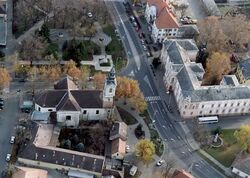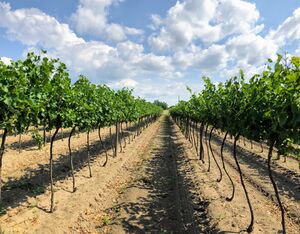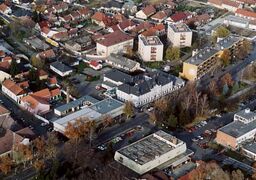كيشكورش
كيشكورش
Kiskőrös | |
|---|---|
| Kiskőrös | |
 Aerial view | |
| الإحداثيات: 46°37′13″N 19°17′02″E / 46.62038°N 19.28381°E | |
| البلد | |
| المقاطعة | باتش-كيشكون |
| المساحة | |
| • الإجمالي | 102٫23 كم² (39٫47 ميل²) |
| التعداد (2009) | |
| • الإجمالي | 14٬452 |
| • الكثافة | 143٫3/km2 (371/sq mi) |
| منطقة التوقيت | UTC+1 (CET) |
| • الصيف (التوقيت الصيفي) | UTC+2 (CEST) |
| Postal code | 6200 |
| مفتاح الهاتف | 78 |
| الموقع الإلكتروني | http://www.kiskoros.hu/ |
كيشكورش ( Kiskőrös ؛ سلوڤاكية: Malý Kereš / Kiškereš؛ باليديشية: קישקעריש Kishkerish ؛ ألمانية: Körösch؛ كرواتية: Kireš[1]) هي بلدة في باتش-كيشكون، المجر. تقع كيشكورش بين نهري الدانوب و تيسا عند الإحداثيات 46°37′14″N 19°17′19″E / 46.62056°N 19.28861°E. شاندور پتوفي، الشاعر الوطني للمجر، وُلِد هنا.[2]
الجغرافيا
كيشكورش هي سادس أكبر مدينة في مقاطعة باتش-كيشكون حسب التعداد. It is located in the center of the county, 22 kilometres (14 miles) east from the river Danube and 110 km (68 mi) south of Budapest. About 2–3 km (1–2 mi) north of the town lies the nature reserve area (since 1974) of Szücsi Forest as part of the Kiskunság National Park. The flora includes close to 300 protected plant species, one of them a special species of orchid, which blossoms here in April. Moreover, there are 98 registered, protected bird species. Many of them are songbirds that coexist with birds of prey like kestrels, sparrow-hawks and hobbies.
المناخ
Kiskőrös has a continental climate combined with a high number of yearly sunlight. The hours of annual sunlight is over 2,000 hours.
التاريخ
Kiskőrös has been populated since the Stone Age. In the first half of the second millennium before Christ it was populated by the Vatya-culture which was developed around the central area of the Danube basin between 2000 and 1500/1400 BC.[3] Archeologists unearthed 161 metal objects - out of them 11 made of gold - in the vicinity of Kiskőrös in 2016, representing the biggest ever Middle Bronze Age found - both quantity and quality - in the areas between the Danube and Tisza (in Hungarian: Duna-Tisza köze).[4][5] In addition to bronze and gold jewellery, daggers, spears, axes as well as goldsmith tools were found. Celtic coins from the Late Iron Age (4th century B.C.) have also been found. In the first century Transdanubia (i.e. Pannonia) was invaded by the Romans and its population ran away and settled in the area. Archaeological evidence suggests that Scythian-Sarmatian were settled here, to the border region, to protect the "limes", who continued to be present up to the 5th century AD. Seven sarmata cemeteries have been found so far within the permiaters of Kiskőrös. In the graves of a Jazig-Sarmatian cemetery a necklace of pearls in gold setting and other rare polished jewellery were found.[6] In the 1930s five Avar villages and seven cemeteries have been discovered. The archeological findings strongly suggest a strong connection between the Sarmatians living in the area and the Roman provinces. Only a few relics were have been found from the Hun-period (420-454). Nine Avar cemeteries have been dug so far. Their characteristic metal buckles with a griffin fitting are strikingly similar to those found in the Caucasus and along the River Volga. The most beautiful findings of all, a necklace of 5 oval almandine pendants in gold setting and 6 gold pendants were uncovered in a princes's grave.[6] The first written documents mentioning Kiskőrös date back to 1277 issued by the "Kuman" László IV and referred to as "Keurus". By 1433 Kőrös was an independent town. The peaceful life of the town came to an end in the 16th century when the Turkish army occupied the region. A letter was written on April 11, 1529 by Mihály Pósa warning the bishop of Kalocsa about the attacks of the Turks. He informs the bishop that Kiskőrös was ruined by the Turks 8 April together with other settlements in the area. The town lceased to exist during the occupation and referred to as "puszta" (lat. desertum). n 1702 documents show that the area was not fully uninhabited. The rebirth of Kiskőrös is the work of the Wattay [7][مرجع دائرة مفرغة] family. For their contribution to defeat the Turks, Leopold I gave the family the land and the surrounding areas.[8] On May 19, 1718 700 Slovak farmers moved to Kiskőrös. The population has reached 5,000 by 1785. On January 1, 1823 Sándor Petőfi was born in Kiskőrös. In the 20th century Hungary lost both world wars and during the years of the Great Depression the economy of the village suffered greatly. Kiskőrös was occupied by the Soviet Army in 1944. After World War II, most of the income came from agriculture (wine and fruit production). In the 1950s, when drilling for oil, salty-iodous-brominous medicinal thermal water of 56 °C was found, forming the basis of the popular thermal bath and swimming pool.[9] Kiskőrös began to develop rapidly in the 1970s and infrastructure, educational, healthcare and welfare institutions were built. Kiskőrös became a town again in 1973.
الاقتصاد
The largest part of the economy is provided by the service sector (family enterprises) and agriculture (mainly related to winegrowing and fruits).
النبيذ
Kiskőrös is situated in the middle of Hungary largest wine producing region, the "Kunsági borvidék" and its history is intimately entwined with wine-making. The sandy soil and high sunshine hours provide the perfect conditions for grape. Viticulture in Kiskőrös is first mentioned in written documents from the XIII. century.[10] For over 200 years there has been a deep tradition of grape production and winemaking in this region. As such, a large percentage of the town workforce has been devoted to the grape and wine industry. Kiskőrös is known for and the local population has strong ties to its wine-growing and winemaking. Winemaking in the town has been more or less a family-based business and multigenerational family winemaking has been an important part of the local culture and self-identity as well as a defining part of family tradition in many local families. The most well-known traditional grapes are: „Kövidinka” – “Ezerjó” – "Sárfehér", "Bianca" and the "Kadarka".
السكان
Kiskőrös had 15,348 residents in 2001. The population is homogeneous with a Hungarian majority. (95.8% Magyars, 3.1% Slovaks, 1.4% Romani, 0.7% Germans etc.). The distribution of religions were: 46.4% Lutheran, 27.5% Roman Catholic, 4.5% Calvinist etc.).[11]
شخصيات
- شاندور پتوفي (1823–1849)، الشاعر الوطني المجري وثوري ليبرالي.[2]
- Jenő Lasztovicza (1961–2015), a Hungarian horticultural engineer, politician and member of the National Assembly.
- Melinda Vincze (مواليد 1983)، لاعبة كرة يد مجري سابق.
المباني والمنشآت
The museum at Sandor Petőfi's birth place is one of the most frequented museums in Kiskőrös. It has been a museum since 1880.[12] Kiskőrös City Mayor's Office was built in 1893.[13] East of Kiskőrös, there is a 150 metres (490 ft) tall concrete tower used for FM radio and television broadcasting.
البلدات التوأم – المدن الشقيقة
 Krimpen aan den IJssel، هولندا
Krimpen aan den IJssel، هولندا لاپوا، فنلندا
لاپوا، فنلندا Liptovský Mikuláš، سلوڤاكيا
Liptovský Mikuláš، سلوڤاكيا Marghita، رومانيا
Marghita، رومانيا Nesvady، سلوڤاكيا
Nesvady، سلوڤاكيا Stadtlengsfeld (درمباخ)، ألمانيا
Stadtlengsfeld (درمباخ)، ألمانيا تارنوف، پولندا
تارنوف، پولندا ژنجيانگ، الصين
ژنجيانگ، الصين
معرض صور
المراجع
- ^ (in كرواتية) "Folia onomastica croatica 14/2005". (462 KB) Živko Mandić: Hrvatska imena naseljenih mjesta u Madžarskoj,
- ^ أ ب
 Bain, Robert Nisbet (1911). . In Chisholm, Hugh (ed.). دائرة المعارف البريطانية. Vol. 21 (eleventh ed.). Cambridge University Press. p. 309.
Bain, Robert Nisbet (1911). . In Chisholm, Hugh (ed.). دائرة المعارف البريطانية. Vol. 21 (eleventh ed.). Cambridge University Press. p. 309. {{cite encyclopedia}}: Cite has empty unknown parameter:|coauthors=(help) - ^ "Revealing the Secrets of 4,000 Year-Old Settlements in Hungary". 14 March 2014.
- ^ Archived at Ghostarchive and the Wayback Machine: "Jelentős bronzkori aranylelet került elő Kiskőrös határában". YouTube.
- ^ "BAON - Szenzációs aranykincsek a bronzkorból". 25 July 2016.
- ^ أ ب "Kisk?r?s - English". www.grunwald.hu. Archived from the original on 2007-10-20.
- ^ hu:Wathay család
- ^ "Kiskőrös - A Wattay család története". Archived from the original on 2007-11-30. Retrieved 2017-04-27.
- ^ http://gotohungary.com/more-spas/-/netaview/37713;jsessionid=AFD1FC9F96BF70F7336238C0A5FECEE6
- ^ "Kiskőrösi Gondűző Borlovagrend". www.borrend.hu. Retrieved 2020-01-09.
- ^ Gazetteer of Hungary 2009 (Hungarian)[dead link]
- ^ https://petofimuzeum.hu
- ^ "Kiskőrös Városháza Épülete". 13 September 2016.
- ^ "Testvérvárosok". kiskoros.hu (in الهنغارية). Kiskőrös. 18 June 2015. Retrieved 2021-03-23.
- Pages using gadget WikiMiniAtlas
- Articles with كرواتية-language sources (hr)
- مقالات المعرفة المحتوية على معلومات من دائرة المعارف البريطانية طبعة 1911
- Articles with dead external links from May 2023
- CS1 الهنغارية-language sources (hu)
- Short description is different from Wikidata
- Coordinates on Wikidata
- Articles containing سلوڤاكية-language text
- Pages using Lang-xx templates
- Articles containing يديشية-language text
- Articles containing ألمانية-language text
- Articles containing كرواتية-language text
- All articles lacking reliable references
- Articles lacking reliable references from January 2020
- Articles with hatnote templates targeting a nonexistent page
- أماكن مأهولة في مقاطعة باتش-كيشكون
- Slovak communities in Hungary
- Jewish communities in Hungary




